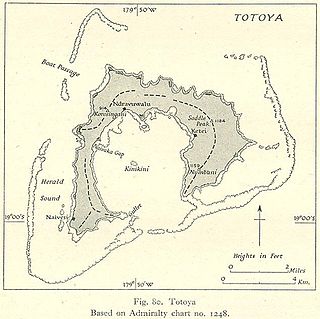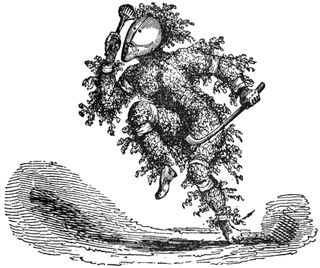Related Research Articles
The House of Chiefs in Fiji consists of the Fijian nobility, composed of about seventy chiefs of various ranks, majority of which are related. It is not a formal political body and is not the same as the former Great Council of Chiefs, which was a political body with a prescribed constitutional role, although the membership of the two bodies did overlap to a great extent.

ʻEnele Maʻafuʻotuʻitonga, commonly known as Maʻafu, was a Pacific islander who held important titles in two countries in the Pacific. He was a traditional Tongan Prince and a Fijian chief nominated and installed by the Tovata chiefs of Lakeba and Vanua Balavu as 'Tui Lau' in 1869. This title was ratified by a wider council of Fijian chiefs and subsequently formalised under British colonial administration. In 1847, Maʻafu went to Fiji in an expedition to Vanua Balavu to investigate the killing of a preacher.
Tui Nayau is the title held by the paramount chief of the Lau Islands in Fiji and is synonymous with the title holders over lordship of these islands. When translated, Tu’i Nayau means "Lord of Nayau", an island north of Lakeba.
Rasolo was a Fijian High Chief.
The Lau Islands of Fiji are situated in the southern Pacific Ocean, just east of the Koro Sea. Of this chain of about sixty islands and islets, about thirty are inhabited. The Lau Group covers a land area of 188 square miles, and had a population of 10,683 at the most recent census in 2007. While most of the northern Lau Group are high islands of volcanic origin, those of the south are mostly carbonate low islands.

Totoya is a volcanic island in the Moala subgroup of Fiji's Lau archipelago. It occupies an area of 28 km2, making it the smallest of the Yasayasa Moala Group. Its maximum elevation is 366 metres above sea level. The main economic activity is coconut farming.
Dranivia was an 18th-century Lauan chief and noble of the Vuanirewa dynasty. He was the third son of Uluilakeba I and last recorded member of the noble household, Naivi, to hold the title Roko Sau of the Lau Islands. He is referred to as an usurper and often oral history does not include hims as a Roko Sau. He is said to have snatched the chieftainship during the absence of his uncle Matawalu from Lakeba, and without the consent of the Vuanirewa. On hearing of his nephew's treachery, Matawalu returned from Bau and reasserted his authority, while Dranivia was touring the Southern Lau islands. Dranivia immediately returned to Lakeba which precipitated in kin slaying amongst the Vuanirewa. Dranivia was defeated and he fled with his supporters to Nayau and establishing the village of Liku.
Laufitu was a Fijian chiefess.

Lomaloma is a village at the south of the island of Vanua Balavu in the Lau archipelago of Fiji. The settlement is part of the tribal district of Tikina, Lomaloma and consists of 9 villages, 13 Yavusa (tribes), 42 Mataqali (clans), and 54 family units known as Tokatoka. The nine villages of Lomaloma Tikina are Lomaloma, Sawana, Susui, Narocivo, Namalata, Uruone, Levukana, Dakuilomaloma, and Tuvuca.
Matawalu was a Fijian chief. He was the son of Niumataiwalu—first Roko Sau of Lau Islands—and Uma of Nukunuku.
Ratu Alifereti Finau was the eleventh Sau ni Vanua of Lau and the fifth Tui Nayau. He was a member of the noble household Matailakeba.
Roko Malani was high chief of the Fijian island of Lakeba. He held the title Tui Nayau and was a popular chief. He increased the influence the island of Lakeba had in Fiji.
Toki Soroaqali was a Lauan chief and member of the noble dynasty of Vuanirewa in Fiji, active in the late 1700s and early 1800s.
Roko Taliai Tupou (17??-1875) was a Fijian nobleman. He is considered to be the progenitor of the noble household Vatuwaqa in the chiefly Vuanirewa clan and as such, was the first member of this noble household to hold the title Tui Nayau. His reign marked the growth of Christianity in Lau and the slow expansion of Tongan ambitions in Fiji, led by Enele Ma'afu. As this period marked increasing contact with Europeans, records from this point forward in regard to the history of Lau are well documented.

Delailoa was a Fijian High Chief.
Sau Mai Kedekede now more commonly referred to as Sau ni Vanua ko Lau is one of the preeminent titles held by the Paramount Chief of the Lau Islands in Fiji.
Kapaiwai Tuimacilai Mara, chiefly seafarer, and descendant of the Vunivalu of Bau.
Kalouyalewa was a Fijian High Chief.
Ratu Jione Atonio Rabici "Tom" Doviverata was a Bau chief and medical doctor and administrator in colonial Fiji.
AdiLalaciwa was a Fijian chiefess and member of the Vuanirewa dynasty on the Lau Islands of Fiji.
References
- ↑ Spurway, John (2015-02-23). Ma'afu, Prince of Tonga, Chief of Fiji: The life and times of Fiji's first Tui Lau. ANU Press. p. 126. ISBN 978-1-925021-18-9.